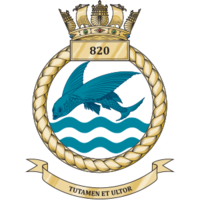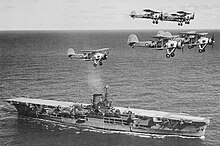
849 Naval Air Squadron was a squadron of the Fleet Air Arm, the Air Arm of the British Royal Navy. It was formed during the Second World War as a carrier based torpedo-bomber, unit, flying missions against Japanese targets in the Far East. Its service since the Second World War has been as an airborne early warning squadron, flying fixed winged Skyraiders and Gannets from the Royal Navy's fixed wing carriers from 1952 until 1978, and airborne early warning Sea King helicopters from 1982 to 2018.

Royal Naval Air Station Culdrose is a Royal Navy airbase located beside the town of Helston, situated on the Lizard Peninsula in southern Cornwall, England, United Kingdom.
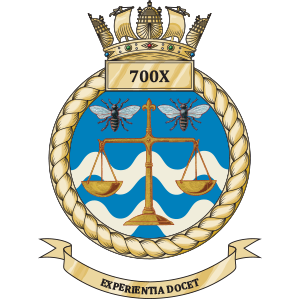
700 Naval Air Squadron is a Fleet Air Arm (FAA) Maritime Unmanned Air System squadron of the United Kingdom’s Royal Navy (RN). Known as 700X Naval Air Squadron, where the 'X' is used to designate 'experimental', it is currently the Royal Navy's Remotely-piloted air systems (RPAS) or 'drone' expert unit.
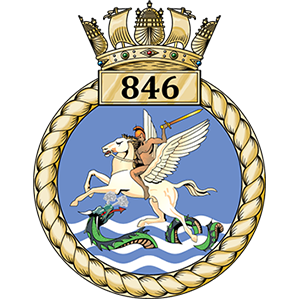
846 Naval Air Squadron is a squadron of the Royal Navy's Fleet Air Arm.

847 Naval Air Squadron is a squadron of the Royal Navy Fleet Air Arm. It operates AgustaWestland Wildcat AH.1 helicopters and provides armed reconnaissance and light transport support to UK Commando Force. Along with 845 and 846 naval air squadrons, it forms part of the Commando Helicopter Force. The squadron was re-formed from 3 Commando Brigade Air Squadron on 1 September 1995.

702 Naval Air Squadron was a Fleet Air Arm (FAA) naval air squadron of the United Kingdom’s Royal Navy (RN) which last disbanded in August 2014. It was last based at HMS Heron, RNAS Yeovilton, Somerset and earlier at HMS Osprey, RNAS Portland, Dorset. As a training squadron it trained all ground and air crew for the sister front-line maritime Lynx unit, 815 Naval Air Squadron. It initially formed during July 1936 as a Catapult Flight for the 2nd Battle Squadron based at RAF Mount Batten and routinely embarking in RN ships such as, HMS Nelson, HMS Rodney and HMS Resolution. By 1939 it was known as 702 Naval Air Squadron but disbanded in January 1940.

857 Naval Air Squadron, was a Fleet Air Arm (FAA) naval air squadron of the United Kingdom’s Royal Navy (RN). It was established at Squantum in the United States as a Torpedo Bomber Reconnaissance squadron in April 1944. It boarded HMS Rajah in June, landed in HMS Gadwall, RNAMY Belfast, Northern Ireland, in July, with anti-submarine training at HMS Landrail, RNAS Machrihanish, Argyll and Bute, Scotland. The squadron re-embarked in September for Ceylon, spending time on land at HMS Garuda, RNARY Coimbatore, India and HMS Ukussa, RNAS Katukurunda, Ceylon, before boarding HMS Indomitable in November. Throughout the winter, using the carrier and HMS Nabbington, RNAS Nowra, Australia as a shore base, the squadron targeted locations in Sumatra, including Palembang, before shifting focus to Sakashima Gunto and Formosa in the spring. The squadron returned to the Far East after VJ-Day to engage Japanese suicide boats off Hong Kong. After leaving its aircraft in Australia, the squadron returned home and was disbanded in November 1945.

815 Naval Air Squadron is a Royal Navy Fleet Air Arm squadron flying the AgustaWestland Wildcat HMA.2 helicopter and is the Navy's front line Wildcat Naval Air Squadron. The squadron is based at RNAS Yeovilton in Somerset. The squadron is capable of carrying out multiple roles such as: counter-narcotics, anti-piracy, Above Surface Warfare (ASuW), search and rescue, disaster relief and flying and engineering training. In the early 2000s, the Navy said that the squadron was largest helicopter squadron in Europe.
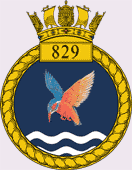
829 Naval Air Squadron was a squadron of the Royal Navy Fleet Air Arm. Before it was decommissioned in March 2018, it operated the AgustaWestland Merlin HM2 helicopter.

701 Naval Air Squadron was a Fleet Air Arm (FAA) naval air squadron of the United Kingdom’s Royal Navy (RN), which last disbanded during September 1958 at RNAS Lee-on-Solent where it was a Helicopter Trials, Communications and Fleet Requirements Unit. It initially formed during July 1936 as a Catapult Flight operating out of Malta and routinely embarking in RN ships such as, HMS Barham, HMS Malaya, HMS Valiant and HMS Warspite. By autumn 1939 it was known as 701 Naval Air Squadron but disbanded in January 1940. It was active twice more during the Second World War, between May 1940 and June 1941 on special duties and then between October 1942 and August 1943 performing anti-submarine patrols. Reforming in April 1945 it was designated a Communications Unit, operating out of Heston until disbanding in 1947. It last reformed as a Fleet Requirements Unit at HMS Daedalus, Lee-on-Solent, during October 1957.
810 Naval Air Squadron was a Royal Navy Fleet Air Arm carrier based squadron formed on 3 April 1933 with the amalgamation of the 12 Blackburn Dart aircraft from 463 and 44 Flight Flights Royal Air Force to the Fleet Air Arm. The squadron saw action during the Second World War, the Suez Crisis and the Korean War.

814 Naval Air Squadron or 814 NAS, nicknamed the Flying Tigers, is a squadron of the Royal Navy Fleet Air Arm. It is currently equipped with the AgustaWestland Merlin HM2 anti-submarine warfare helicopter and is based at Royal Naval Air Station (RNAS) Culdrose in Cornwall. The squadron was formed in December 1938 and has been disbanded and reformed several times.
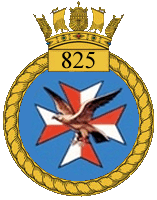
825 Naval Air Squadron is a Royal Navy Fleet Air Arm Naval Air Squadron which was re-commissioned on 10 October 2014 and currently flies the AgustaWestland Wildcat HMA2.

824 Naval Air Squadron is a Royal Navy Fleet Air Arm squadron based at RNAS Culdrose and currently operating the AgustaWestland Merlin HM2 Operational Conversion Unit. It trains aircrew in Anti-Submarine warfare and Airborne Surveillance and Control.

826 Naval Air Squadron was a Fleet Air Arm aircraft squadron formed during World War II which has been reformed several times since then until last disbanded in 1993.

737 Naval Air Squadron was a Fleet Air Arm (FAA) naval air squadron of the United Kingdom’s Royal Navy (RN). It was initially active during 1943 as an amphibious Bomber Reconnaissance Training Squadron. Reactivated in 1944 it operated as an ASV Training Unit until 1945. It was active again between 1949 and 1957. From 1959 it was the Anti-Submarine Warfare school at RNAS Portland. It operated Westland Wessex HAS.3 rescue helicopters from their land base at RNAS Portland, Dorset.

706 Naval Air Squadron was a Fleet Air Arm (FAA) naval air squadron of the United Kingdom’s Royal Navy (RN). Established as a fighter and torpedo-bomber training unit in Australia at the end of World War Two, it was briefly reformed as a helicopter squadron in the early 1950s, before becoming a helicopter training unit in 1962, and operating until 1998.

707 Naval Air Squadron was a Fleet Air Arm (FAA) naval air squadron of the United Kingdom’s Royal Navy (RN) which disbanded during February 1995. The unit was operational during the Second World War, having been established in February 1945 under the designation of Radar Trials Unit and subsequently disbanded in October of that year. It was reformed in December 1964 as an Advanced and Operational Flying Training (AFT/OFT) Commando helicopter squadron.

744 Naval Air Squadron is a Fleet Air Arm (FAA) naval air squadron of the United Kingdom’s Royal Navy (RN). It was originally established in 1943 in Nova Scotia and has undergone various re-designations and reformations throughout its history. The squadron has transitioned from early air gunner training to anti-submarine warfare and trials, and in 2018, it reformed at MoD Boscombe Down as the Mission Systems and Armament Test and Evaluation Squadron. Now, in 2024, 744 Naval Air Squadron is taking on the new role of Joint Uncrewed Air System Test and Evaluation Squadron, leading the Ministry of Defence's efforts in UAS testing and evaluation.

772 Naval Air Squadron was a Fleet Air Arm (FAA) naval air squadron of the United Kingdom’s Royal Navy (RN) which last disbanded during September 1995. 772 Naval Air Squadron formed as a Fleet Requirements Unit out of 'Y' Flight from 771 Naval Air Squadron at RNAS Lee-on-Solent in September 1939. While the headquarters remained there, floatplanes were operated out of RNAS Portland, however, mid 1940 saw the whole squadron move north to RNAS Campbeltown and roughly twelve months afterwards the short distance to RNAS Machrihanish. The unit moved to RNAS Ayr in July 1944 and became the Fleet Requirements Unit School. In January 1946 the squadron moved to RNAS Burscough in Lancashire, before moving to RNAS Anthorn in Cumberland, in May. It became the Northern Fleet Requirements Unit upon moving to RNAS Arbroath, in June 1947, but disbanded into 771 Naval Air Squadron in October. 772 Naval Air Squadron reformed as a Helicopter Support Squadron at RNAS Portland in September 1974. In September 1977 the squadron took over responsibility for a number of Ships' Flights of Royal Fleet Auxiliary ships. The squadron was used to reform 848 Naval Air Squadron for the Falklands Task Force in 1982, with the Ships' Flights absorbed into 847 Naval Air Squadron. In August 1982 it took on the Anti-Submarine Warfare Flight from 737 Naval Air Squadron and between 1983 - 1985 a Search and Rescue Flight operated out of RNAS Lee-on-Solent.
